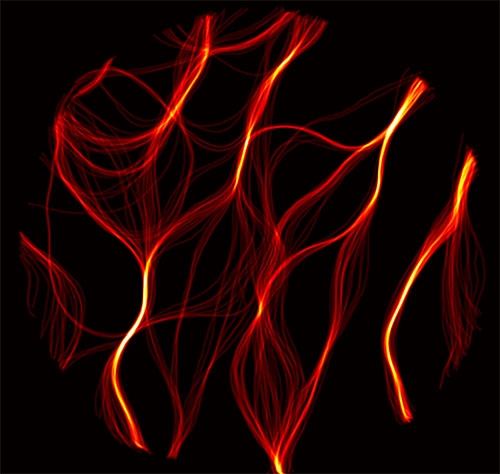Revealing Collective Electronic Orderings in Space and Time
April 12, 2023
 enlarge
enlarge
The image shows the areas where the borders of magnetic domains accumulate over time, and thus define the presence of pinning sites.Credit: Nature 614, 256–261 (2023).
The Science
Scientists developed a new analysis technique — named coherent correlation imaging (CCI) — to directly image fluctuating and dynamic collective electronic ordering with high time and space resolution. It resulted in direct visualization of domain wall dynamics for the first time.
The Impact
Understanding the dynamical behavior of magnetic materials at the nanoscale offers a pathway to developing new technology that harnesses material properties for data storage, processing, and potential advanced applications (including in QIS).
Summary
From refrigerator magnets to particle accelerators, magnetism is used in many everyday applications and has influenced our technology for decades. Even though we use magnetism in many form, scientists continue to struggle to really understand how magnetism behaves on the smallest scales. On the near-atomic level, magnetism is made of many ever-shifting kingdoms—called magnetic domains—that create the magnetic properties of the material. While scientists know these domains exist, they are still looking for the reasons behind this behavior.
In this study, a team of researchers developed and used a novel analysis technique—called coherent correlation imaging (CCI)—to image the evolution of magnetic domains in time and space without any previous knowledge. Their measurements show a how the boundaries of some domains shift back and forth while others barely move. The researchers attribute this behavior to a property of the material called “pinning.” While pinning is a known property of magnetic materials, the team could directly image for the first time how pinning sites affects the motion of interconnected domain walls.
The team measured the domain wall movement using the Coherent Soft X-ray Scattering (CSX) beamline at the National Synchrotron Light Source II. The beamline is part art of the advanced suite of research tools available at NSLS-II for studying materials. NSLS-II is a U.S. Department of Energy (DOE) Office of Science user facility located at DOE’s Brookhaven National Laboratory.
The developed algorithm allowed the researchers to categorize the images and to reconstruct a movie of the domain movement. This movie then enabled them to connect the domain behavior to the pinning sites on the sample. This allowed them to formulate the existence of attractive and repulsive pinning sites. While attractive sites can accommodate domain walls, repulsive sites inhibit the movement of domain walls.
This study is an important step along the way to understanding how to manipulate skyrmions and other magnetic domains for future applications. In addition, CCI’s usefulness also represents a breakthrough beyond magnetic materials since the technique can be transferred to different measurement techniques and research areas.
Download the research summary slide (PDF)
Contact
Wen Hu
National Synchrotron Light Source II
wenhu@bnl.gov
Felix Büttner
Massachusetts Institute of Technology
felix.buettner@helmholtz-berlin.de
Publications
C. Klose, F. Büttner, W. Hu, C. Mazzoli, K. Litzius, R. Battistelli, I. Lemesh, J. M. Bartell, M. Huang, C. M. Günther, M. Schneider, A. Barbour, S. B. Wilkins, G. S. D. Beach, S. Eisebitt, B. Pfau . Coherent correlation imaging for resolving fluctuating states of matter. Nature 614, 256–261 (2023). https://doi.org/10.1038/s41586-022-05537-9
Funding
Work at MIT was supported by the DARPA TEE program. Work at MBI was supported by the Leibniz Collaborative Excellence program. Work at HZB was supported by the Helmholtz Young Investigator Group Program. This research used resources (beamline 23-ID-1, CSX) of the National Synchrotron Light Source II, a US Department of Energy (DOE) Office of Science User Facility operated for the DOE Office of Science by Brookhaven National Laboratory under contract no. DE-SC0012704.
2023-21603 | INT/EXT | Newsroom









